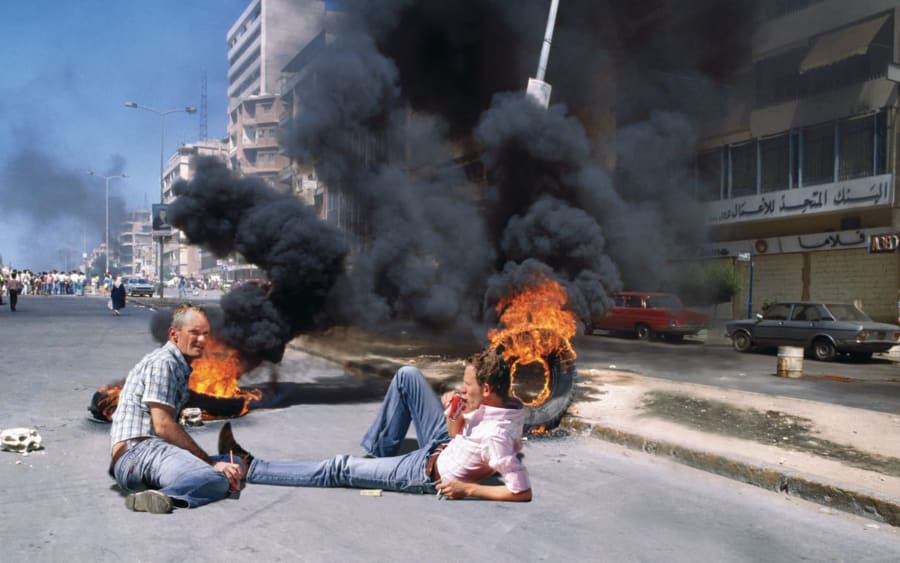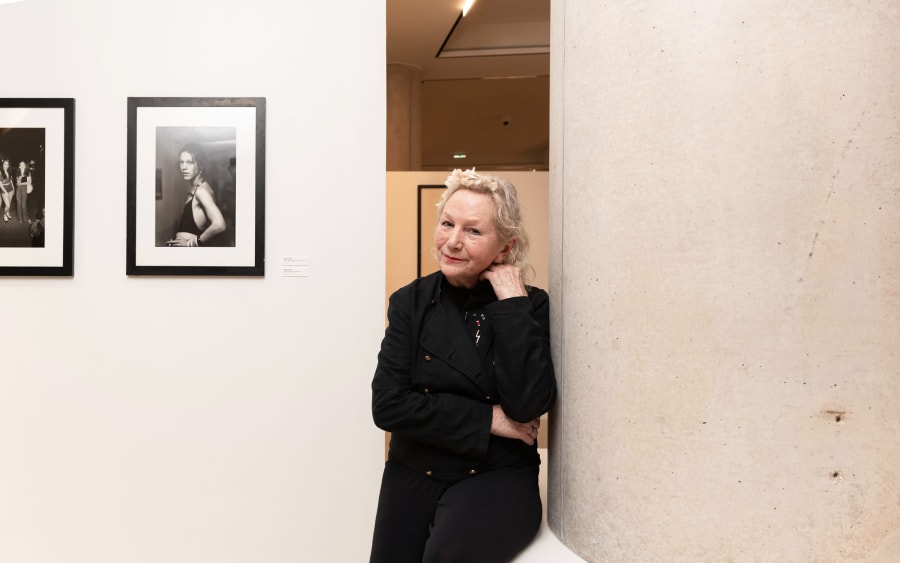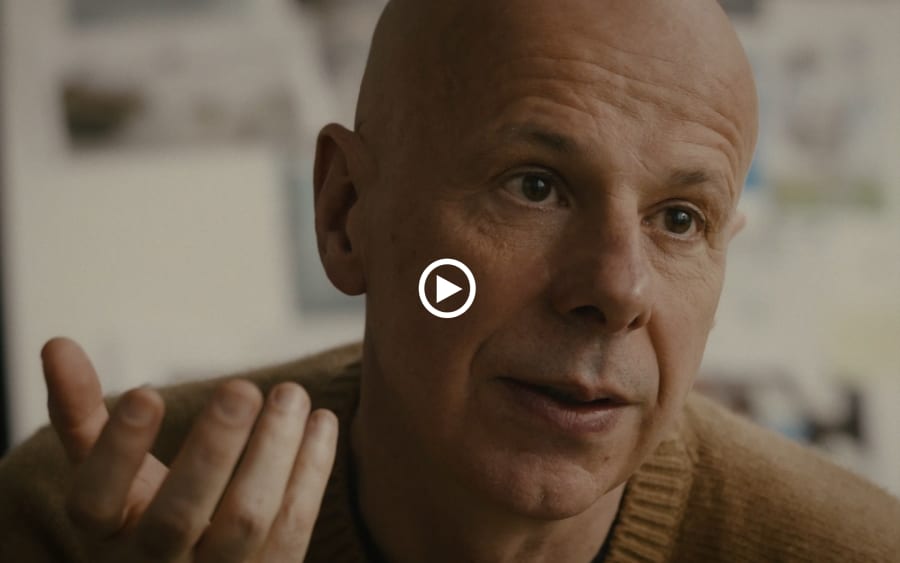Painted with a tremulous touch and a bleached and fleeting palette, a picture by Luc Tuymans can look as if it’s not quite sure whether it deserves to exist. Invited by the Louvre’s Head of Contemporary Programs, Donatien Grau, to paint directly onto the walls of the world’s most visited museum, Tuymans chose the Rotonde Valentin de Boulogne. This painting-free, octagonal knuckle of a space on the second floor is usually little more than an empty, transitional zone between the Sully and Richelieu wings. ‘I went through the entire Louvre,’ says Tuymans, ‘and I picked that particular spot, because it’s at the crossroads of French and Flemish painting.’ Titled L’Orphelin, or The Orphan (2024), the four-part painting will be washed away after a year, the walls restored to their original emptiness. Shortly after the official unveiling, I talked to the Antwerp-based artist about the project and what he hopes it might achieve.
Painted directly onto the walls with the aid of a projector and fast-drying, nontoxic theater paint, L’Orphelin unfolds over four parts and tackles two subjects. For three of the four walls, Tuymans derived his source imagery from a YouTube video featuring an artist from New Zealand cleaning his brushes. The subject matter appears banal, the forms are ambiguous and haunting– none of which is unusual with Tuymans. In one of the paintings, a gloved hand hangs limp like a surgeon’s might after slicing a body open, with specks of red pigment on an apron adding to the macabre potential of the image. The other two are fragmented, map-like, and barely legible; they could come across like a mid-century work by an imitator of Robert Motherwell. The large scale of the paintings is disorientating. As passersby drift between wings, the marks on the walls may not even register immediately as images: the pallid, almost monochromatic palette contributes to the air of abstraction – even confusion – in the room. ‘They are huge details, or blow ups of details,’ explains Tuymans, ‘which is interesting because the restored painting by Van Eyck, who is pretty tough on details, is there, upstairs – so in that sense the paintings become references to where I come from.’
Tuymans is referring to Jan van Eyck’s recently restored Chancellor Rolin in Prayer before the Virgin and Child (c. 1430), the only painting by the Flemish master in the Louvre’s collection. Among the countless vivid details (and by ‘pretty tough,’ I think Tuymans means that nobody painted details quite like Van Eyck), are the chancellor’s hands raised in prayer and baby Jesus’s in benediction – details that offer an ironic counterpoint to the dangling glove in Tuymans’s own painting, a floor away. The artist makes the connection to his august predecessor with a mix of pride and bemusement. ‘Everybody goes to see La Gioconda. Maybe the brothers Van Eyck didn’t invent oil painting, but they perfected it, and the method was stolen by Pisanello, actually enabling Leonardo to make his first masterpiece.’
The fourth wall in the rotunda features a looming, disembodied head, viewed from behind. The image is based on Tuymans’s own lost painting of the back of a doll’s head titled The Orphan (1990). Working from an old slide, he resurrected the earlier painting partly to reference a specific episode in the history of Paris – and the Louvre in particular. ‘The painting suggests a decapitated head and the moment when the guillotine becomes much more commonly used coincides with this specific space becoming public.’ In 1793, amid the Reign of Terror, the Louvre changed from royal palace to public institution, becoming a palatial setting for the nation’s masterpieces, with Jean-Honoré Fragonard appointed one of the museum’s first curators at the recommendation of Jacques-Louis David.
I point out that the museum also holds a fantastic painting by Henri Bellechose, Retable de Saint Denis (1416), in which the founder of the mighty cathedral on the other side of Montmartre is seen getting his head chopped off. But when I push the beheading theme, Tuymans downplays it: ‘It’s in the background, a side product,’ he says, broadening the conversation to the whole presentation. ‘It’s about the idea that you have an anonymous situation, and on the other side you have the presence of a figure – in a sense concealed because he’s showing his back to you – but nonetheless a commanding presence because it is piercing the other paintings.’ Tuymans talks about deconstructing the images of the YouTube videos and reconstituting them as blown-up details that occupy the whole wall, and that, by remaking his own painting, he creates a mise en abîme of the whole project. The artist’s earlier Orphan, lost for more than 30 years, is resurrected as an ephemeral wall painting – lost, recreated, and then destined to be washed away forever.
Countless visitors will pass through the rotunda, phone in hand, in hot pursuit of another masterpiece, barely pausing to take breath. This isn’t a new problem. Indeed, years ago Louvre curators decided to move the Poussins from this space because even the great master of stillness failed to slow the visitors down. Tuymans revels in these almost comic, paradoxical scenarios. ‘This is a passageway, where they’ll see a painter cleaning his brushes, and the back of an enormous, disembodied head,’ he says. ‘Nevertheless, it plays in your head that you’re in an institution that is the biggest museum in the world, with the largest collection, and also megalomaniacal in its propositions, with a specific history of looting. In that sense it was interesting to make this sort of environment, and I was very happy that this is an octagonal space that envelops the spectator when they go through it, disorienting them, and showing a detail that they could see in other paintings. There is an element of halting or pausing, although it is a transitional space.’
The Orphan not only offers a fresh lick of paint to the institution’s hallowed walls, but also a quick blast of bewilderment between hall after hall of tawny, timeless masterpieces. If Tuymans is playing at being the palace jester, he nonetheless can’t leave his abiding themes behind – trauma, violence, theft, the history of painting. When we spoke, I was struck by his playful intelligence as he delighted in all the possible effects and ramifications of his presentation, and his eagerness to stress a degree of openness and ambiguity. Van Eyck’s hands, Poussin’s magisterial compositions, Da Vinci’s sfumato, a selfie in front of the Mona Lisa – all of these visual experiences color how the visitors will encounter Tuymans’s painting. I suggest to him that a lot of them will be at the Louvre for the first and only time and will scarcely notice that they are surrounded by the work of one of the great painters of our era. ‘This is a space of real interruption, a completely different idea to hanging a work of my own in the space,’ he says, adding that when he was halfway through the project, and still painting, he watched as people entered, baffled. ‘You could see immediately they were disoriented because the paintings occupied the entire wall. They didn’t know what they were experiencing.’
‘L'Orphelin par Luc Tuymans’
Until May 26, 2025
Musée du Louvre, Paris
Craig Burnett is the author of Philip Guston: The Studio, Afterall Books, 2014.
Luc Tuymans is represented by David Zwirner (New York, Los Angeles, London, Paris, Hong Kong).
Caption of the header image: Luc Tuymans at the Louvre in front of the Orphelin in the rooms of the Paintings Department, Musée du Louvre 2024. © Musée du Louvre. Photography: Florent Michel.
Published on July 3, 2024.


